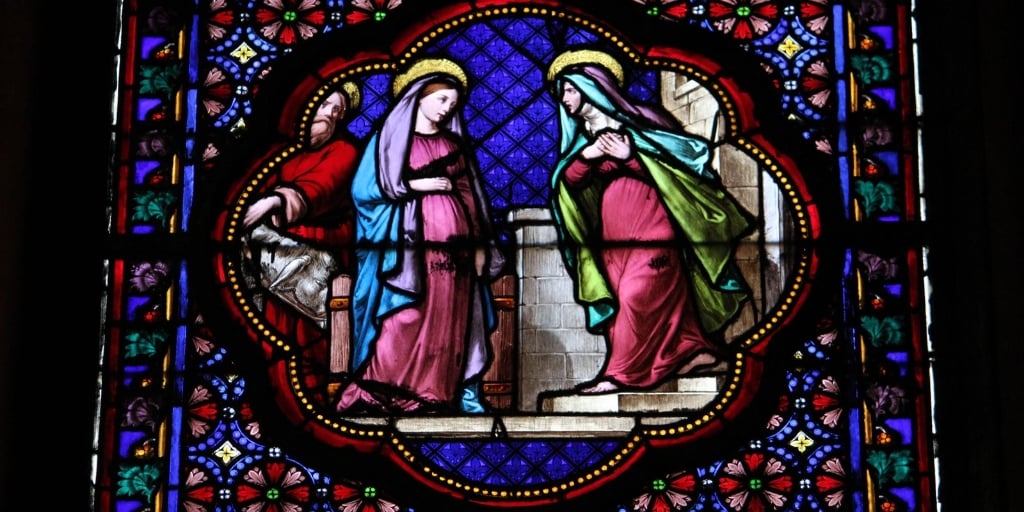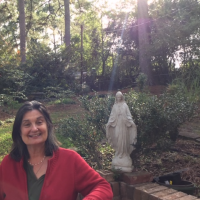
Julie Vickery contemplates the Visitation and the joyful hope that guides hearts opened wide to Jesus, through Mary.
A few years ago, I came across a poem by Saint John of the Cross that I enjoy revisiting every so often, especially during this time of the year: “The Virgin, weighed with the Word of God, comes down the road: if only you’ll shelter her” (See: The Collected Works of St. John of the Cross, translated by Kieran Kavanaugh, OCD, and Otilio Rodriguez, OCD). This short work — which is likely part of a hymn Saint John wrote for Advent — readily evokes images of the young Virgin Mother of God traveling the road to Bethlehem. However, Saint John, a master of the spiritual life, writes with deceptive simplicity. In other words, his seemingly straightforward single-sentence poem invites close reading and serious reflection that prompts the reader to see parallels with Scripture, Tradition, and his or her own life experiences.
_-_The_Visitation_-_RCIN_403971_-_Royal_Collection.jpg?width=1375&name=After_Carlo_Maratti_(1625-1713)_-_The_Visitation_-_RCIN_403971_-_Royal_Collection.jpg)
With all this in mind, I came to see that the road the Virgin “comes down” could just as well lead to the hill town of Judah and the home of Elizabeth, a relative, who has conceived a son in her old age (Lk 1:36). Surrendering her will to God’s will, Mary sets out “in haste” to visit the older woman in need (1:39). When she enters the home of Zechariah and Elizabeth, the Virgin Mother is greeted with joy — first, by Elizabeth’s son, who “leaped” in Elizabeth’s womb the instant she heard Mary’s greeting (v. 41).
Filled with the Holy Spirit and a heart opened wide with humility and love for the Lord and his Mother, Elizabeth cries out: “Most blessed are you among women and blessed is the fruit of your womb. And how does it happen to me that the mother of my Lord should come to me (42)”; Elizabeth goes on to praise Mary’s abiding faith in God’s plan of salvation: “Blessed are you who believed what was spoken by the Lord would be fulfilled” (45).
Reading Saint John’s poem in the light of the above Gospel, I wonder now if the doors of my heart are always open to welcoming Jesus, through Mary. What about friends and relatives in need? Do I always greet them and offer aid with a generous and consoling heart? What about strangers? Do I do my best to be kind and give help as freely as I am able? Or do I tend to give reluctantly?
Finally, I ask myself: Am I zealous in my love for the Lord. Do I show my love by imitating Mary, who always points us towards her Son? As I reflect on my everyday life, I must admit there is much work to be done as I seek to grow in my love relationship with Jesus, attained through Mary.
Mercifully, over the course of my long and often bumpy spiritual journey, I have found in Scripture and in the writing of the saints a good number of aids for advancing in the spiritual life.
Here are five suggestions you may find helpful:
- Pray the Rosary daily.
- Commit to reading Scripture every day, for at least ten minutes.
- Resolve to help a neighbor struggling with loneliness or anxiety concerning a family member who is perishing spiritually. Ask Mary to intercede for them.
- Pray for the poor souls in Purgatory who have no one else to pray for them.
- Bear Christ to everyone, everywhere, in every situation.
Takeaway:
Saint John of the Cross, standing on Scripture, tells us that Mary brings Jesus to us, wherever we may be, if only we open our hearts to her and, thus, to her Son. To make this awareness part of everyday life, it would be helpful to form a habit which can be easily practiced often, throughout the day. For example, seek Mary’s aid under her various titles; ask help for yourself and for others: “Handmaid of the Lord, pray for us”; “Helper of the Redeemer, pray for us”; “Model of virtue, pray for us,” and so on.
Copyright 2020 Julie Vickery
Images (top to bottom): "The Visitation" stained glass in the Basilica Sainte-Clotilde-Sainte-Valère, Paris (2011), CC BY 2.0; "The Visitation" anonymous painting, Public Domain
About the Author

Julie Vickery
Julie Vickery is a wife and mother of two grown children. She has a Master of Arts degree in Sacred Theology and enjoys continuing her studies online. Other favorite pastimes include reading and writing nonfiction, gardening, walking and taking part in local and online inter-faith discussion groups.


.png?width=1806&height=731&name=CatholicMom_hcfm_logo1_pos_871c_2728c%20(002).png)
Comments